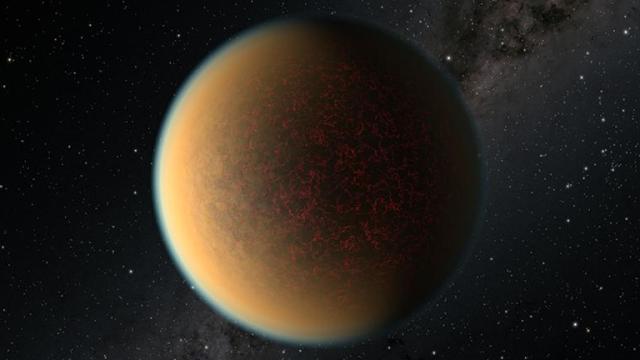Who says you can’t lose your atmosphere to a nearby red dwarf and then grow a new one with the help of volcanic activity? This resilient planet, located 41 light-years from Earth, appears to be thriving again after a rough encounter with its host star.
Exoplanet GJ 1132 b is both similar to and very different from Earth. Sure, it’s several times wider than our planet, but both worlds share similar densities and atmospheric pressures, and both popped into existence approximately 4.5 billion years ago. And like our planet, it started off hot, with an atmosphere rich in hydrogen, and then gradually cooled down.
The backstories of these two planets are distinctively different, however.
Whereas Earth has always been a terrestrial, rocky world, GJ 1132 b began its life as a gaseous, Neptune-like planet. But as new research shows, a nearby red dwarf obliterated its original hydrogen- and helium-rich atmosphere with powerful radiation, so GJ 1132 b, having been stripped down to its rocky core, is now technically a terrestrial planet. The new paper will appear in an upcoming issue of the Astronomical Journal, but a preprint is available at the arXiv.
The authors of the paper reached these conclusions based on direct observations of the exoplanet and theoretical modelling. The telescope of choice was the Hubble Space Telescope, which allowed the team to spot the “secondary atmosphere,” which consists of molecular hydrogen, hydrogen cyanide, methane, and an aerosol haze resembling smog on Earth.
“It’s super exciting because we believe the atmosphere that we see now was regenerated, so it could be a secondary atmosphere,” Raissa Estrela, a co-author of the study and a planetary scientist at NASA’s Jet Propulsion Laboratory in Southern California, explained in a statement. “We first thought that these highly irradiated planets could be pretty boring because we believed that they lost their atmospheres. But we looked at existing observations of this planet with Hubble and said, ‘Oh no, there is an atmosphere there.’”
In terms of an explanation, the authors say much of the planet’s current hydrogen was retained from before, having been absorbed into the molten magma mantle. Volcanic processes are now causing this stored hydrogen to leak out from below, refuelling the new atmosphere, according to the research.
“This process works early in a planet’s life, when the star is hotter,” said JPL scientist Mark Swain, lead author of the study, in the NASA release. “Then the star cools down and the planet’s just sitting there. So you’ve got this mechanism where you can cook off the atmosphere in the first 100 million years, and then things settle down. And if you can regenerate the atmosphere, maybe you can keep it.”
GJ 1132 b, which takes just 1.5 days to make one complete orbit of its hungry host star, is probably prone to tidal heating, in which gravitational forces churn the planet from within. The exoplanet, despite its short year, is in an elliptical orbit, resulting in an effect known as “gravitational pumping.” As GJ 1132 b swings back and forth, it alternates between squashing and stretching actions, producing an engine that drives the tidal forces and, in turn, the preservation of a liquid mantle.
The surface of this exoplanet is probably not very thick, maybe only a few hundred feet deep, according to the authors. The terrain is likely quite flat, with cracks caused by the tidal pumping actions, from which the hydrogen steadily leaks out.
[referenced id=”1665685″ url=”https://gizmodo.com.au/2021/01/bizarre-cotton-candy-planet-is-changing-our-sense-of-whats-possible/” thumb=”https://gizmodo.com.au/wp-content/uploads/2021/01/20/hbsvplflb7948t1efmsi-300×169.jpg” title=”Bizarre ‘Cotton-Candy’ Planet Is Changing Our Sense of What’s Possible” excerpt=”An exoplanet located 212 light-years away is roughly the same size as Jupiter, but it’s 10 times lighter. The discovery is challenging our conceptions of how gas giants form and grow and the types of planets that can exist.”]
The new study has implications for the study of similar worlds located elsewhere in the galaxy.
“The detection of an atmosphere on this rocky planet raises the possibility that the numerous powerfully irradiated Super-Earth planets, believed to be the evaporated cores of Sub-Neptunes, may, under favourable circumstances, host detectable atmospheres,” the authors write in the study.
The big question now is, how often does this happen? Is this merely a freak occurrence? That could be answered by the upcoming James Webb Space Telescope, which, with its infrared capabilities, should be able to spot planets such as this with ease. What’s more, JWST could also be used to study GJ 1132 b and provide new data to affirm these results.
